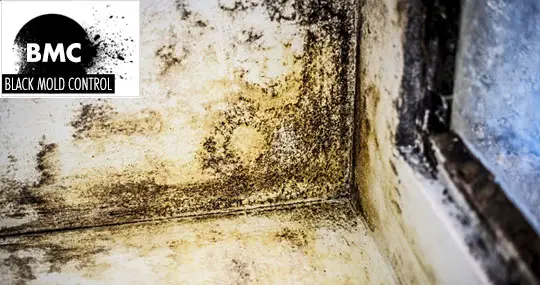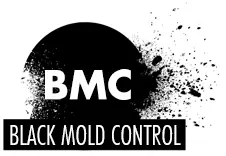Did you ever thought about black mold on windows? The condensation and moisture that forms on your windows might be of no concern, that is until you see little black specks begin to form. It isn’t uncommon to spot mold on window sills if there is persistent moisture. Here are a few tips on how you can take care of it!

Table of contents
Causes and health risks
Mold often grows in areas where there is a lot of condensation and high humidity. It reproduces by spores that are carried in air currents and can grow on most surfaces where moisture is present. This makes windows with lots of condensation a perfect location for growth. According to the Centers for Disease Control and Prevention, “molds can cause nasal stuffiness, throat irritation, coughing or wheezing, eye irritation, or, in some cases, skin irritation.
People with mold allergies may have more severe reactions. Immune-compromised people and people with chronic lung illnesses, such as obstructive lung disease, may get serious infections in their lungs when they are exposed to mold.” (Facts about Mold and Dampness, 2017)
Remove mold from window sills
Because black mold reproduces through spores that can be airborne, it spreads. If it is not removed, it can spread to other parts of the home and become more difficult to remove. Mold is a micro-organism. This means that individual colonies can only be seen with a microscope. Although a surface may look clean, it may still have small colonies growing. For this reason, removal can be difficult.
Cleaning mold from all types of windows
So you’ve spotted mould on your windows and are ready to tackle the issue. It may not be as easy as it sounds! Some products may remove the black spots, but the actual black mould is still on the surface. For example, bleach may work to remove the spots, but will not completely kill it. It will continue to grow back, due to the microscopic colonies on the area. The right cleaning supplies are essential to getting your windows black mold-free.
The types of cleaning supplies you will need and how to handle the black mold depends on the surface it is growing on. If the surface is porous, then the it will penetrate deeper and be harder to remove. You may need to scrub well or use a stronger disinfectant. Surfaces that are less porous should be easier to clean as the it cannot penetrate as deeply.
Some precautions should also be taken with all spore removal. Seal off the room you are cleaning from the rest of the house and wear goggles and a face mask. Be sure that your goggles and face masks have solid seals as the spores can be inhaled and cause illness.
Wooden frames
Wood is a porous material, making it more difficult to remove the spores. Hydrogen peroxide is a good option for removing it from wooden frames and sills. The liquid penetrates the porous material and is anti-fungal and anti-bacterial.
To remove it, simply use a 3% concentration of hydrogen peroxide in a spray bottle. Saturate the sills and frames with the liquid and wait 10 minutes. Afterward, scrub the area to remove the spots and color. Finally, wipe to remove any residual spores. Hydrogen peroxide is a good option as it leaves no fumes and is nontoxic. Hydrogen peroxide will kill the spores from the root and prevent future growth.
Seals are sold to prevent future growth. Seals are not a good option for wood that is hard to clean as sanding will send spores into the air that can be hazardous. If you decide to use seals, be sure that the wood is thoroughly cleaned and free of mold. Otherwise, the seals can trap the particles and possibly stimulate make the problem worse.
Read our in-depth article on: how to remove mold from wood.
Aluminum and PVC frames
Aluminum and PVC windows are made of hard, non-porous materials. It should be easier to clean these surfaces. Vinegar is a good option in cleaning black mould from these areas.
Place undiluted white vinegar in a spray bottle and spray the sills and frames. Scrub the black spots and then spray generously again. Let the vinegar sit for an hour before rinsing. If you do not mind the smell, you can also leave it to dry, and the smell should go away in a few hours.
Window air conditioner
Air conditioners can be a source of condensation. If your window air conditioner starts to have a musty smell, there may be mould growth inside. Turn off your air conditioning unit immediately. As the air blows through the filter, microscopic spores can spread throughout your home and can even make you sick. You can attempt to clean the filters and unit, but it may be easier and safer to replace it. The problem may reside in the filters, which can be replaced.
If you change the filters and there is still a musty scent, then you may have to replace the ac unit. Be sure to check the window frames and sills for any growth as well. It may be a good idea to wipe down the area with hydrogen peroxide just to be sure. Check other windows for signs of growth as well.

How to prevent black mold on windows
The type of product that will work for you will also depend on the material the black mold/mould is growing on and the environment. If the area is humid and condensation is often found on the window frames or sills, this can lead to mould. Running an exhaust fan or opening windows can help remove some of the condensation.
Moisture is the enemy to prevention! Proper ventilation can prevent growth as well. If there are any spots that water is leaking, it is important to dry those immediately. Mould can even make its way in between window panes with the help of condensation, so it is important to keep a lookout on potential problem areas. Wood seals are also an option for prevention as well as sealing cracks. However, be sure the area is dry before sealing. Open seals that are loose may also be a source of mold. Do you have black mold in your apartment? Read about tenants rights on our article: Black mold in apartment.
When to consult a professional
If the area you are trying to clean is extensive, a professional should be called in. Attempting to clean it yourself can lead to illness or make the situation worse. A professional can safely clean the mould and prevent future growth.
